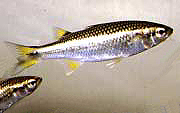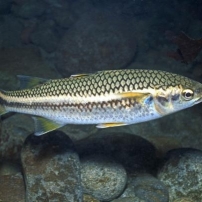
Agonostomus monticola
FAMILY
Mugilidae
TAXONOMY
Mugil monticola Bancroft, 1834, Jamaica. Agonostomus monticola
is morphologically variable. Several different species have been
recognized from Central America and the West Indies, but a
review in 1997 listed them as conspecific.
OTHER COMMON NAMES
French: Mulet de fleuve; Spanish: Lisa de rнo, tepemechнn.
PHYSICAL CHARACTERISTICS
Grows to 14.2 in (36 cm) in total length. Dorsal surface of head
is convex between the eyes. Teeth are small and attached directly
to the jawbones. Pharyngobranchial organ is rudimentary.
There are 16–23 gill rakers on the lower part of first gill arch.
Anal fin has two spines and 10 soft rays in adults. There are
38–46 scales in a longitudinal series along the flanks. Body is
brownish, sometimes with a silvery band on the flanks from the
pectoral to the caudal fin. Dorsal, anal, and caudal fins are dusky
yellowish; there is a dark spot at the base of the caudal fin.
DISTRIBUTION
Rivers of the West Indies, Central America, Colombia,
Venezuela, and the Galapagos Islands. Occasionally reported
from the rivers of Florida and Louisiana.
HABITAT
Freshwaters of fast-flowing hill streams.
BEHAVIOR
Little is known.
FEEDING ECOLOGY AND DIET
Diet varies seasonally. Omnivorous, feeding mainly on insects,
prawns, fruits, and algae.
REPRODUCTIVE BIOLOGY
Adults may spawn in the lower reaches of rivers or in the sea.
Spawning apparently correlates with peak rainfall. Larvae and
juvenile fish spend perhaps six weeks at sea before migrating
back upstream.
CONSERVATION STATUS
Not threatened.
SIGNIFICANCE TO HUMANS
There are small commercial and subsistence fisheries in the
West Indies and Central America.
Other popular Animals
Photo Gallery of - Mountain mullet





 Animalia Life
Animalia Life